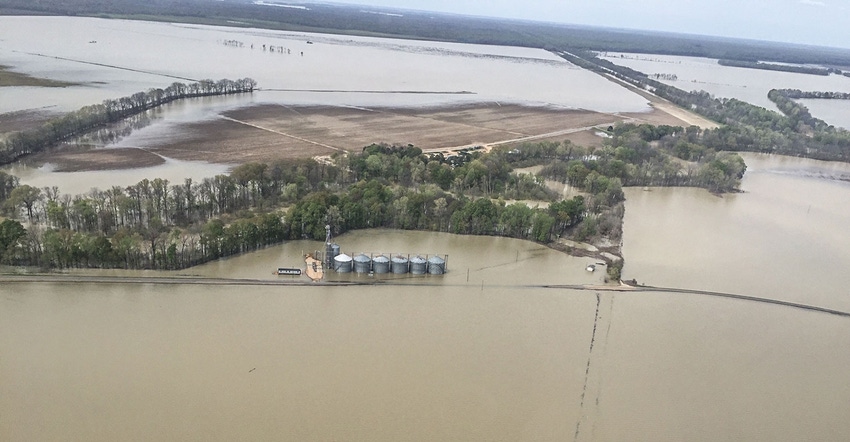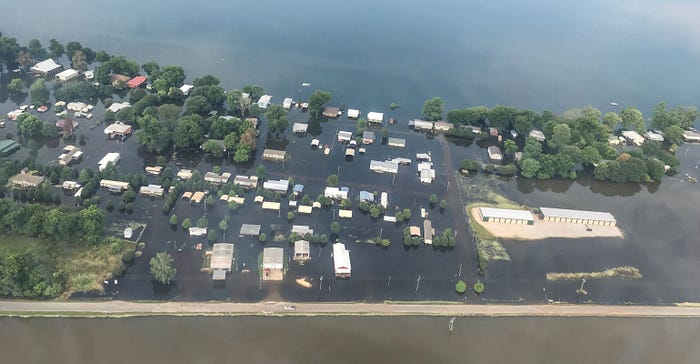
With the help of positive comments being submitted to the Corps of Engineers by the end of November 2020, the Yazoo Backwater Project is looking to move forward toward building the pumps.
Peter Nimrod, chief engineer of the Mississippi Levee Board, answered a few questions about where the Yazoo Backwater Project is currently in the process of getting the pumps in place. Also, he gave information on how supporters can help the project be accepted by submitting positive comments on the Corps of Engineers' draft proposal.
Where is the Yazoo Backwater Project in the process of getting the pumps in place?
Looking back, the 2019 Backwater Flood was a record flood. It flooded 548,000 acres of land, which included 231,000 acres of cropland, and it flooded 686 homes and three highways. Two people died during the flood from drowning in their cars. It was a terrible, terrible occurrence. However, it woke a lot of people up.
People realized how horrible this was for farmers because no crops were planted on 231,000 acres of farmland last year. Also, look at what happened to the wildlife and the environment. Trees and animals died because of all the flooded land in the Delta.
It opened a lot of eyes. The Environmental Protection Agency (EPA) had vetoed the pump project back in 2008, but during the 2019 backwater flood, the United States Army Corps of Engineers invited EPA to come and see what had happened. When they saw the devastation to the people, homes, cropland, animals, and the environment, they said they couldn't let this happen again.
The EPA and the Corps went to the drawing board and discussed a new project, one that wouldn't be subject to the veto. The Corps proposed two major changes to EPA in December 2019 for a new project.
First, they moved the pumping station from Steele Bayou up to Deer Creek. By moving the pump station about 10 miles east, it intercepts most of the water coming out of the drainage basin, which is a huge drainage basin of 2.62 million acres total, and 82% of the drainage basin comes from the Big Sunflower River basin. Deer Creek intercepts the water from the Big Sunflower River and keeps it from inundating the Steele Bayou basin by pumping it over the levee. It's much better for flood control when you move the pump location to Deer Creek.
What is the environmental impact of getting the pumps in the Yazoo Backwater and how can it help farmers and wildlife alike?
The second big change to the new proposal is putting in 34 supplemental low-flow groundwater wells. The 34 water wells will be near the levee along the west side of the Delta. In the springtime, when heavy rains flood the South Delta, the pumps will pump the water over the Yazoo Backwater Levee for flood control purposes. In the fall, when the rains subside and the streams in the interior of the Mississippi Delta go dry, the low flow wells will be cut on to put water back into the streams to sustain the fisheries and aquatic life.
Now, it is a year-round project by controlling flooding in the springtime with the pump and adding water back with the wells in the fall time when the rivers' water is low. We have a great project with great environmental benefits. There are no net losses at all, and there are gains in every environmental resource category. By moving the pumps to the new location, natural gas will be used to run the pumps, which is better than diesel fuel to help reduce the carbon footprint.
When we get the pumps put in place, it will significantly lower flood levels and decrease the duration of the floods in the spring for the Mississippi Delta. It'll help remove homes from the path of the hundred-year flood in the South Delta, which is incredible. It will remove all highways from the flood zone.
The wildlife and terrestrial animals will have enough dry land to survive during a backwater flood. The wells in the fall will put water back into the Delta to keep the environment sustainable for fisheries and aquatics.

What are the next steps in the project?
The Corps released what they call the Draft Supplemental Environmental Impact Statement (Draft SEIS) on October 16. The statement is now out for public review, so people can read the project's details. Currently, the next step to the project is the comment period, ending on Nov. 30. We need everybody interested in these pumps to submit a comment in favor of the project to the Corps. We desperately need these pumps to help protect farms, homes, highways, and lives. Also, we need it for the environment and wildlife.
Once the comments are submitted, the Corps will finalize the report, and they're hoping they can release that final report sometime in mid-January. At that time, they would sign what they call a Record of Decision, which says they're moving forward with the project. If everything lines up, we can start right away designing and building the project. The best-case scenario is that by the end of 2025 the pumps and wells will be in place. In just a few years, we'll have the protection we desperately need for flood control, and we'll also have the added benefits for the environment thanks to the wells.
We're thrilled that the Corps brought all this together so quickly, and we're thrilled the EPA has worked with the Corps to develop this plan to help move it forward.
How can people submit comments to help the project move forward?
The Corps of Engineers has released the Draft SEIS II for the Yazoo Backwater Project recommending that the pumps be built. The Corps is accepting comments on the Draft SEIS until the end of November.
To support the project, there are four different ways to submit a positive comment to the Corps in favor of the pumps.
To submit a comment via the website for tablets or computers, please visit www.forgottenbackwaterflood.com where a digital submission form can be found.
To submit a comment through your smartphone, text PUMPS to 50457. A link will then be texted to you that will lead to a submission page to fill out your information and submit a comment with the option to add a personalized message if you wish.
To submit a comment via email, please email your comment directly to [email protected].
To mail a comment or personalized letter, please mail to: District Engineer, U.S. Army Corps of Engineers, Vicksburg District, 4155 Clay Street, Vicksburg, MS 39138-3435.
About how much land and money could be saved by using the pumps to prevent backwater floods?
The pumps are going to remove well over a hundred thousand acres of agriculture land out of the hundred-year flood plain. It's going to be very significant for protecting agricultural land. The pumps will lower the Base Flood Elevation (BFE), which is the 100-year flood, by about 5.1 feet. This reduction removes the vast majority of homes and all highways out of the hundred-year flood zone.
Some farmland will not be flooded at all while other farmland will still get flooded, but the duration is going to be a lot shorter, increasing the possibility of planting a crop.
The Corps made some estimates from the last 13 years, from 2008 until 2020, about how much money could have been saved with the use of a pump. If we had the pumps, we would have prevented about $406 million in agriculture damages alone, not including infrastructure, homes, or people's livelihoods. This also does not include land that couldn't be planted at all, but only includes planted crops that got destroyed.
In 2019 and 2020, a lot of acres couldn't be planted, and $324 million is estimated to be lost revenue from not being able to plant crops. If you look at just the USDA Crop Insurance Payments made to this area since 2008, it's about $350 million the government spent on flooding and crop damages. Added up, we're talking about over a billion dollars' worth of damage that could have been prevented had we had the pumps. The project is very economically justifiable. With the floods we've had in the last 13 years, this project could pay for itself in a few years.
Our thanks go to the Corps of Engineers and the EPA as well as the Mississippi Department of Wildlife Fisheries and Parks, the Mississippi Forestry Commission, and the Nature Conservancy for supporting the project. We're excited about how close we are to these pumps becoming a reality.
About the Author(s)
You May Also Like




